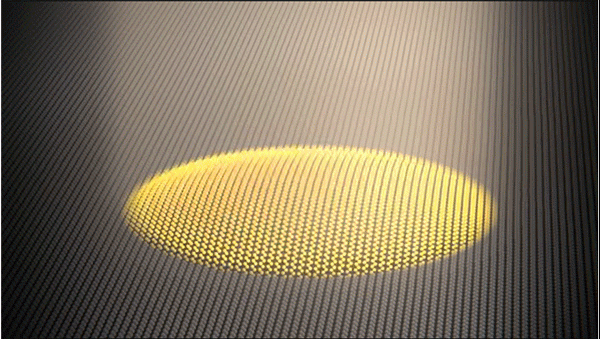Under the microscope, graphene-covered silicon wells show up as dots of different colours. Researchers think they may use the effect in energy-efficient displays.
PhD researcher Santiago Cartamil-Bueno and his supervisor Dr. Samer Houri from the Kavli Institute of Nanoscience (Faculty of Applied Sciences) had made a series of silicon wells with 13-micron diameter. They covered the pits with a double layer of graphene (1-atom thick layer of honeycomb-structured carbon), which laid as a batter head over the nano drums.
Under the microscope, Cartamil-Bueno noticed that the wells had various colours. “At first, I was disappointed,” he said. “I wanted to use the wells as sensors, and I realised that the colours meant they were not homogeneous. That’s not a good sign when you’re creating sensors.”
To make matters more complex, the colours changed over time. Researchers began to understand that pressure differences between the well and the outside pushed on the membrane like air in a balloon. The graphene simply responds to changing pressures.
Interference of light waves reflected by the bottom of the well and the graphene membrane results in changing colours. Incident white light turns red when the balloon is inflated, or blue when the membrane gets sucked in.
Researchers from TU Delft and colleagues from the Spanish company Graphenea S.A. reported on their findings in the American Chemical Society’s journal Nano Letters. At the end of the article, they suggest the effect may be used as a passive display, known as interferometric modulator display or IMOD. Such displays are targeted for low-energy applications such as smart watches and e-readers.
For a display, the driving force has to be electric rather than pneumatic. Cartamil-Bueno has revealed that he succeeded in realising a deflection of the graphene membrane electrostatically. He adds: “Indeed, we will show a graphene-based prototype screen controlled electrically in the Mobile World Congress 2017.” That conference will take place in Barcelona February 27 – March 2, 2017.
Cartamil-Bueno is confident the graphene IMOD, or GIMOD, will allow full-colour displays. He stated: “As it is, the colours will never be monochromatic (or mono-ranged around a particular wavelength) which is not an issue in principle. Mirasol technology from Qualcomm/Apple has the same problem and they are commercialising products. I could think of tricks to make the pixels more selective.”



Comments are closed.